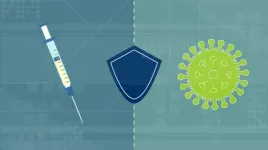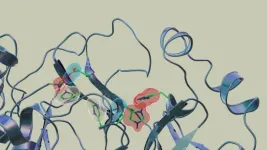Individual SARS-CoV-2 neutralising antibody immunity lasts from days to decades
2021-03-24
(Press-News.org) SINGAPORE, 23 March 2021 - Scientists from Duke-NUS Medical School, the National Centre for Infectious Diseases (NCID) and the Agency for Science, Technology and Research (A*STAR) Infectious Diseases Labs found that antibodies against SARS-CoV-2 wane at different rates, lasting for mere days in some individuals, while remaining present in others for decades. The study, published in The Lancet Microbe, shows that the severity of the infection could be a deciding factor in having longer-lasting antibodies. Individuals with low levels of neutralising antibodies may still be protected from COVID-19 if they have a robust T-cell immunity.
The team followed 164 COVID-19 patients in Singapore for six to nine months, analysing their blood for neutralising antibodies against SARS-CoV-2, T cells and immune system signalling molecules. They then used this data to establish a machine learning algorithm to predict the trajectories of peoples' neutralising antibodies over time.
"The key message from this study is that the longevity of functional neutralising antibodies against SARS-CoV-2 can vary greatly and it is important to monitor this at an individual level. This work may have implications for immunity longevity after vaccination, which will be part of our follow-up studies," said Professor Wang Linfa, from Duke-NUS' Emerging Infectious Diseases (EID) Programme, a corresponding author of the study.
The team was able to categorise people into five groups depending on how long their antibodies lasted. The first group, who never developed detectable neutralising antibodies also called the 'negative' group, comprised 11.6 per cent of the patients in the study. The 'rapid waning' group (26.8 per cent) had varying early levels of antibodies that waned quickly. The 'slow waning' group (29 per cent) tested mostly positive for antibodies at six months. The 'persistent' group (31.7 per cent) showed little change in their antibody levels up to 180 days and, finally, the 'delayed response' group (1.8 per cent) showed a marked rise in neutralising antibodies during late convalescence.
While this study focused on determining the levels of neutralising antibodies, which are part of the body's comprehensive immune defence system, the other important aspect of an effective immune defence is T-cell immunity. The study found that the patients tested, including those from the 'negative group', displayed sustained T-cell immunity six months after initial infection. This shows that individuals may still be protected if they have a robust T-cell immunity when the neutralising antibody level is low.
"Our study examines neutralising antibodies which are important in protection from COVID-19. We found that antibodies against SARS-CoV-2 wane in different people at different rates. This emphasises the importance of public health and social measures in ongoing pandemic outbreak response. However, the presence of T-cell immunity provides hope of longer-term protection which will require more studies and time for epidemiological and clinical evidence to confirm," said Associate Professor David Lye, Director, Infectious Disease Research and Training Office, NCID, also a corresponding author of the study.
"This study reminds us that we all react differently to infection and that various people mount different protective immune responses. Understanding the basis of these differences will help build better vaccines," added Professor Laurent Renia, Executive Director, A*STAR Infectious Diseases Labs.
The findings are important as policy makers design vaccination programmes and pandemic exit strategies. The rate of antibody waning suggests re-infection may occur in subsequent waves of infection. Also, if immunity provided via vaccinations wanes like naturally-produced antibodies, then annual vaccine administration could be necessary to prevent future outbreaks of COVID-19. Further research will be needed to clarify this as vaccine programmes are rolled out.
INFORMATION:
ELSE PRESS RELEASES FROM THIS DATE:
2021-03-24
A University of Birmingham-led study of top-flight UK rugby players - carried out in collaboration with the Rugby Football Union (RFU), Premiership Rugby, and Marker Diagnostics - has identified a method of accurately diagnosing concussion using saliva, paving the way for the first non-invasive clinical test for concussion for use in sport and other settings.
Following the team's previous research, which identified that the concentration of specific molecules in saliva changes rapidly after a traumatic brain injury, the researchers embarked on a three-year study in elite rugby to establish if these 'biomarkers' could be used as a diagnostic test ...
2021-03-24
Potentially paves way for non-invasive diagnostic test at all levels of participation
On a par with the assessment currently provided in professional sports
Could work alongside 'gold standard' head injury protocol used in elite sports
Distinct chemical 'signatures' for concussion have been identified in the spit of elite male rugby players, reveals research published online in the British Journal of Sports Medicine.
This potentially paves the way for a non-invasive and rapid diagnostic test for the condition that could be used pitch side and after the game at all levels of participation, suggest the researchers.
This is especially important because ...
2021-03-23
Scientists at the U.S. Department of Energy's Ames Laboratory have observed novel helical magnetic ordering in the topological compound EuIn2As2 which supports exotic electrical conduction tunable by a magnetic field. The discovery has significant implications for basic research into functional topological properties and may one day find use in a number of advanced technology applications.
Topological materials burst onto the scene in the physical sciences about fifteen years ago, decades after their existence had been theorized. Called 'topological' because their bulk electronic bands are "knotted" together, the surfaces of topological insulators "untie the knot" and become metallic. Researchers ...
2021-03-23
People who received a flu shot last flu season were significantly less likely to test positive for a COVID-19 infection when the pandemic hit, according to a new study. And those who did test positive for COVID-19 had fewer complications if they received their flu shot.
These new findings mean senior author Marion Hofmann Bowman, M.D., is continuing to recommend the flu shot to her patients even as the flu season may be winding down.
"It's particularly relevant for vaccine hesitance, and maybe taking the flu shot this year can ease some angst about the new COVID-19 vaccine," says Hofmann, an associate professor of internal medicine and a cardiologist at the Michigan ...
2021-03-23
While COVID-19 cases may be on the decline, the virus is still prevalent nationwide, and higher education institutions need to prepare for a successful 2021 academic year. New research from Clemson University in The Lancet Child & Adolescent Health, one of the world's premier peer-reviewed general medical journals, indicates how surveillance-based informative testing (SBIT) mitigates the spread of COVID-19 on campus, paving the way for other institutions, even those without the infrastructure or funding for mass-scale testing.
SBIT was implemented during the first two weeks of the Fall semester at Clemson. According to the study, ...
2021-03-23
Another step towards understanding Alzheimer's disease has been taken at the Maisonneuve-Rosemont Hospital Research Centre. Molecular biologist Gilbert Bernier, and professor of neurosciences at Université de Montréal, has discovered a new function for the BMI1 gene, which is known to inhibit brain aging. The results of his work have just been published in Nature Communications.
In his laboratory, Bernier was able to establish that BMI1 was required to prevent the DNA of neurons from disorganizing in a particular way called G4 structures. This phenomenon occurs in the brains of people with Alzheimer's disease, but not in healthy elderly ...
2021-03-23
Scientists have found new, unexpected behaviors when SARS-CoV-2 - the virus that causes COVID-19 - encounters drugs known as inhibitors, which bind to certain components of the virus and block its ability to reproduce.
Published in the Journal of Medicinal Chemistry, the research provides key insights for advancing drug design and drug repurposing efforts to treat COVID-19.
Researchers at the Department of Energy's Oak Ridge National Laboratory used neutron scattering to investigate interactions between telaprevir, a drug used to treat hepatitis C viral infection, and the SARS-CoV-2 main protease, the enzyme responsible for enabling the virus to reproduce.
They ...
2021-03-23
When the human immunodeficiency virus infects cells, it can either exploit the cells to start making more copies of itself or remain dormant--a phenomenon called latency. Keeping these reservoirs latent is a challenge. A new paper, published in the Proceedings of the National Academy of Sciences, has found a way to look for chemicals that can keep the virus suppressed into its dormant state.
"The current drug treatments block healthy cells from becoming infected by the virus," said Yiyang Lu, a PhD student in the Dar lab at the University of Illinois Urbana-Champaign. "The latent reservoir poses a bigger problem because it can start producing the virus at any time. Consequently, patients have to remain on antiretroviral therapy all their lives to prevent ...
2021-03-23
Boston - Wearing masks and physical distancing - two key infection prevention strategies implemented to stop the spread of COVID-19 - may have led to the dramatic decrease in rates of common respiratory viral infections, such as influenza. A study led by researchers at Boston Medical Center (BMC) showed an approximately 80 percent reduction in cases of influenza and other common viral respiratory infections when compared to similar time periods in previous years, before wearing masks, physical distancing, and school closures were implemented to help stop the spread of COVID-19. Published online in Open Forum Infectious ...
2021-03-23
SAN ANTONIO (March 23, 2021) -- More than half of all health care workers worldwide are experiencing burnout that, if not addressed, could cause many to leave their fields in favor of less-stressful occupations or choose early retirement. And the COVID-19 pandemic has only made it worse.
That's the warning of a surgeon from The University of Texas Health Science Center at San Antonio in a letter and a call for global action published March 22 in the Lancet journal EClinicalMedicine.
"A recent survey done in Medscape of nearly 7,500 physicians globally showed that burnout has reached a very high rate," said END ...
LAST 30 PRESS RELEASES:
[Press-News.org] Individual SARS-CoV-2 neutralising antibody immunity lasts from days to decades

